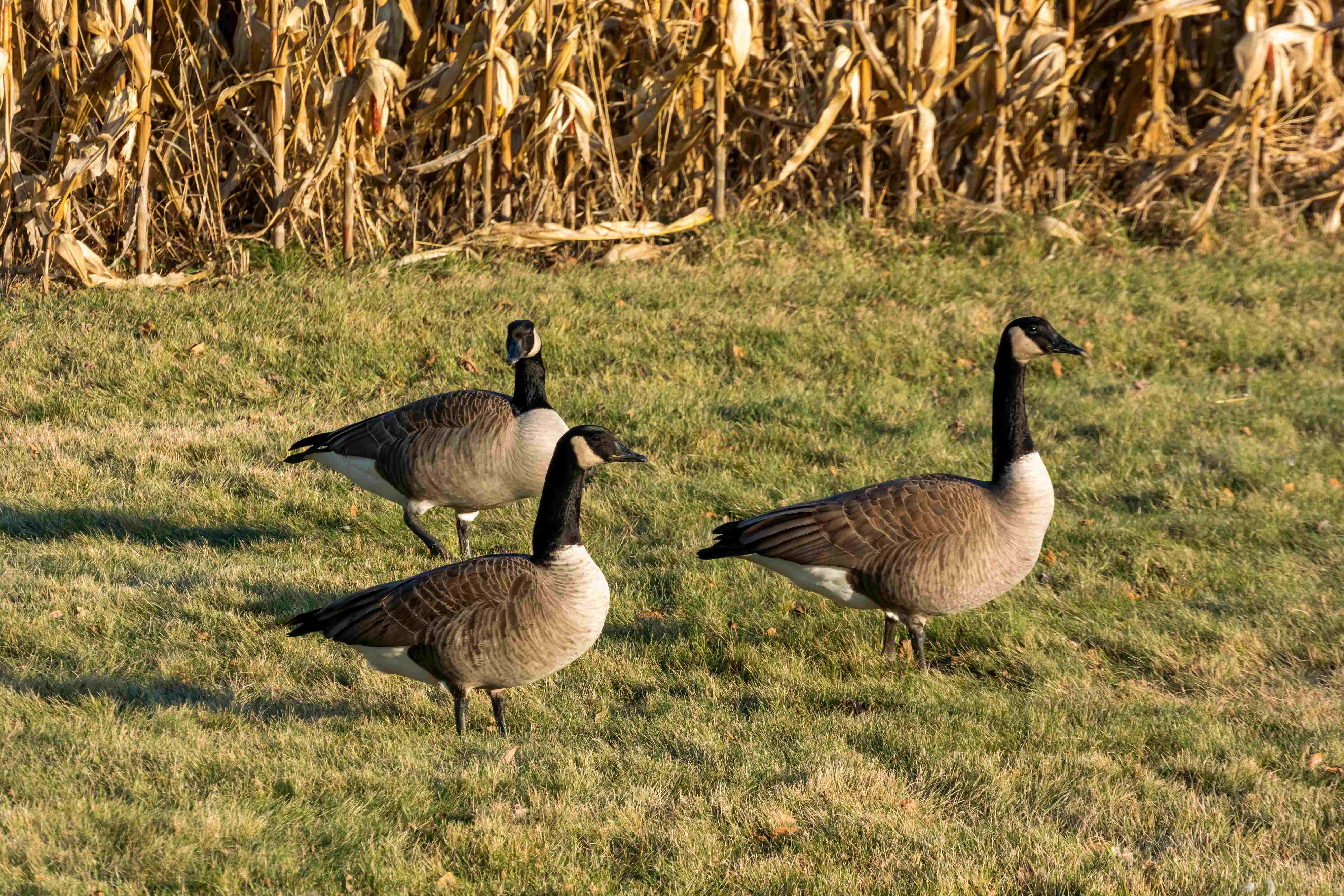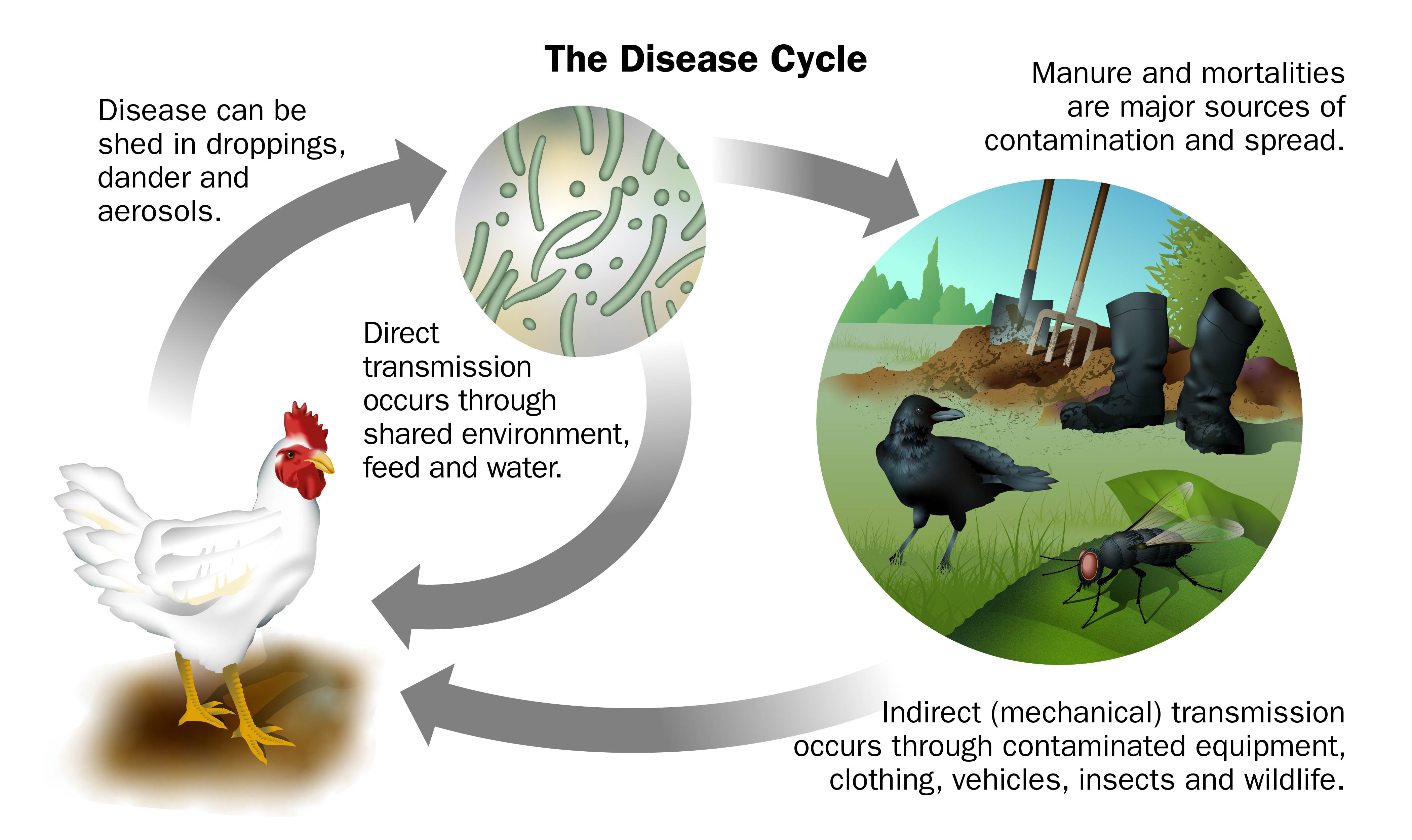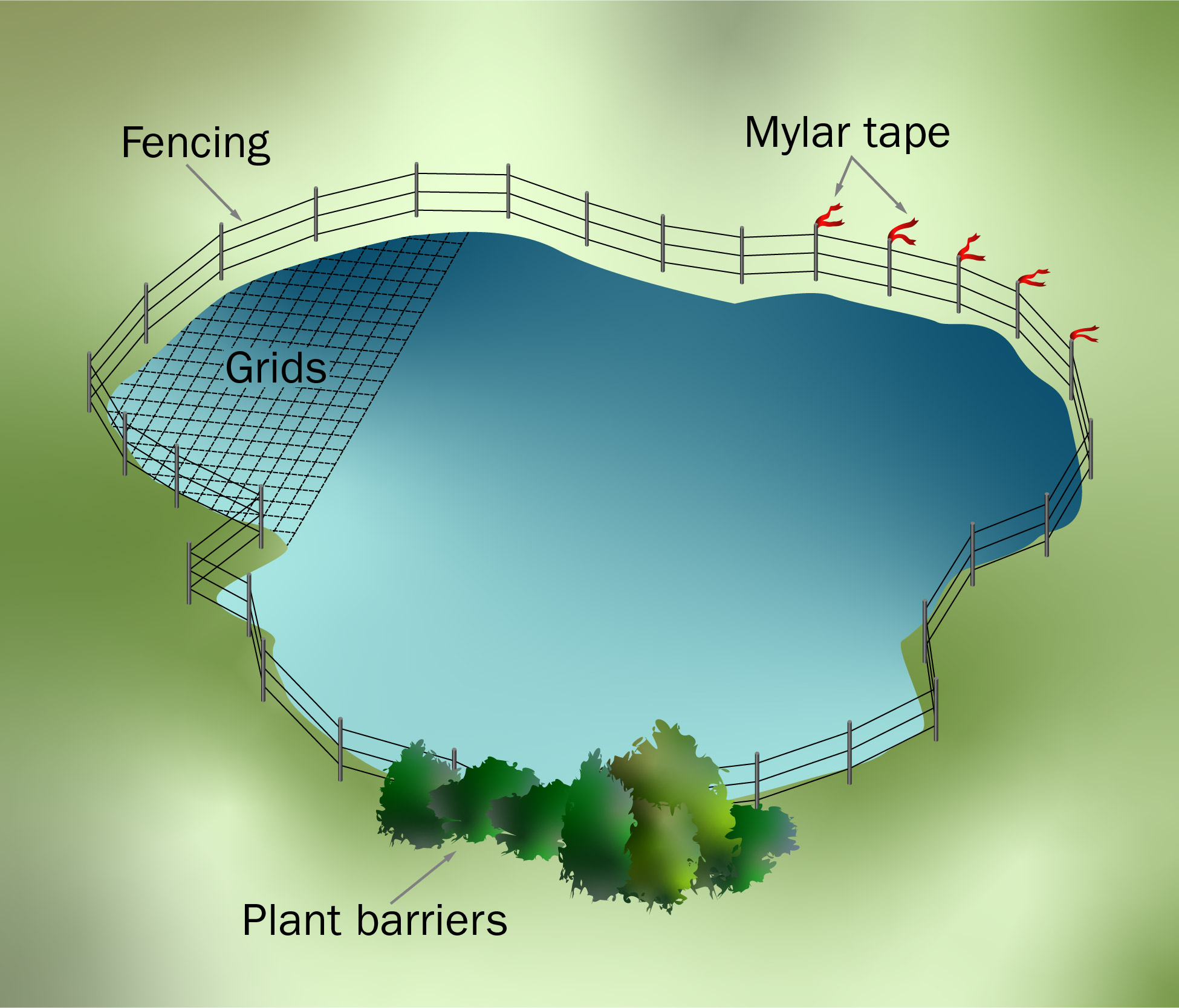Management of nuisance Canada geese and other migratory birds on commercial poultry operations
Learn suggested solutions and steps to prevent nuisance geese.
ISSN 1198-712X, Published March 2023
Introduction
Migratory birds, such as Canada geese, are federally protected by the Migratory Bird Convention Act, 1994, and Migratory Birds Regulations, 2022. Under this legislation, it is illegal to kill, disturb or destroy migratory birds and their eggs without a permit.
These birds can pose a serious problem to Ontario poultry farmers since they are able to carry a range of diseases along their flight path. Even when birds appear to be healthy, they may be carrying disease. They can transfer pathogens between farms, to other wildlife and to different locations, threatening the health status of commercial and backyard flocks (Figure 1). Migratory waterfowl are capable of carrying avian influenza (AI) across continents during their annual migration.

Source: Shutterstock.

There are 2 main routes of disease transmission between wild birds and domestic flocks (Figure 2):
- direct transmission (for example, a wild bird gains access to your barns)
- indirect transmission (for example, contamination of feed, water and bedding supplies, shared tools and boots)
Keeping wild birds and domestic birds separate is important. Fortunately, it is possible to deter wild birds and protect flocks with simple management techniques. It is important to remember that all deterrent techniques work best in combination and as a preventive measure. Often, removing sources of feed, water and potential nesting sites will be enough for birds to leave the property on their own.
Steps to prevent nuisance geese
Assess the problem
Before implementing any control method, the problem must be properly analyzed. Ask yourself questions such as:
- How many birds are there?
- What is the age and natural behaviour of the migratory bird? (nesting, raising young)
- What season of the year is it?
- How long have the birds inhabited the area?
- What is attracting the birds to this location? (food, shelter, water sources)
Assess potential solutions
When deciding the best solution, it is important to practically assess the entire situation. Consider:
- Are my actions safe?
- Do I have the right equipment?
- Are there any consequences for pets, children and neighbours?
- Are my actions practical?
- Could this make the problem worse?
- Did the information gathered on management come from credible sources?
- How would the general public view my actions?
- Are my actions justifiable to others?
- Are my actions legal?
- Is there federal, provincial legislation or local bylaws that have to be considered?
- Is there local legislation that may prohibit firearm use, excessive noise and/or light pollution?
Suggested solutions for farmers
Making your property less attractive to migratory birds is the best way to keep birds away.
Food sources
Reduce or remove food sources by:
- removing food sources from the area (for example, grass, cultivated grains, seeds, berries and vegetables)
- posting signs to discourage feeding of wild birds
- sharing your concerns about migratory birds and the biosecurity risk for your flock with your neighbours
- storing feed properly and clean up any spilled feed
Modify the landscape
Modify the area around your property. Adjusting the existing landscape can be an effective long-term solution for managing geese conflicts. Methods include:
- Mowing grass less frequently, especially in the areas bordering a body of water. Geese prefer young tender grass and are often deterred by long coarse grasses. Producers should check On-Farm Food Safety Program (OFFSAP) Guidelines to ensure this is an acceptable option.
- Seeding grass with a less appetizing, coarse or repellent grass species (consult your local seed supplier for a suitable solution in your area).
Create barriers
Establish barriers that discourage geese by removing clear lines of sight for landing, reducing visibility of predators and blocking escape routes. Ensure barriers are placed at entrances and exits to bodies of water and farm areas.
Create barriers around bodies of water to make them unattractive to migrating geese (Figure 3):
- Plant barriers: Dense and tall grass, shrubs, aquatic plants, trees and bushes prevent birds from directly accessing shorelines, grazing areas and shelter by blocking visibility.
- Fences: Woven wire, snow fencing, monofilament wire, and poultry or plastic netting are effective at blocking water access and walking routes. Fences should be tall enough to stop both adults and goslings, and prevent birds from walking around, underneath or through them.
- Grids: Wire, cable, twine or rope can be arranged in grids or multiple parallel lines, and should be supported at 30–50 cm above the pond or planting surface.
- Flight path barriers: Plant trees or hang high visibility ropes (for example, Mylar tape) to reduce the ability for geese to predict landing paths. Ropes should be elevated with some slack to increase visibility in the wind.

Actions to consider when scaring away pre-moulting geese
The following are actions you can consider to assist in scaring away pre-moulting geese:
- Scaring should begin when migratory birds first arrive and must be carried out consistently until they leave the area. Scaring works best when geese first settle in an area, or in conjunction with other management techniques.
- Noise deterrents can effectively displace geese but must be adjusted regularly to prevent adaptation to the device. Using irregular intervals and multiple devices may increase efficiency. Examples include propane cannons, air horns, sirens and recorded distress or predatory calls. Notifying your neighbours prior to using any of these may reduce the potential for complaints.
- Visual deterrents come in a variety of different forms and can usually operate unattended. These devices are effective on their own but work best in combination with noise deterrents. To prevent adaptation to the device it must be regularly moved or altered. Examples include strobe lights, lasers, balloons, kites, scarecrows and flags.
- Motion-activated sprinklers can operate unattended and are very energy efficient, however they are limited in area of effectiveness.
- Dogs can be used to encourage birds to leave by chasing and harassment, but a federal permit is required.
Scaring techniques that require a federal permit from Environment Canada
Scare tactics that require a federal permit include the use of:
- firearms
- raptors
- aircraft
- dogs
Scaring techniques involving any firearm or aircraft (including drones) require a permit. Many municipal bylaws also prohibit firearm discharge. In agricultural settings, a “kill to support scaring” technique can be very effective. This involves using a shotgun to kill a few birds from a flock to discourage others from returning to the area. However, hunters must obtain a federal migratory game bird hunting permit in addition to required provincial permits before hunting. Additional information on permits is available from the federal government at Migratory bird permits and registries.
Permits for addressing agricultural damage or danger to livestock are available from the Canadian Wildlife Service (CWS). Applicants must demonstrate that all other reasonable management techniques have been attempted and failed. There is no fee for damage or danger permits. For more information on permits and migratory bird management, please contact the CWS at ec.priseaccessoire-incidentaltake.ec@canada.ca or call
The Ministry of Natural Resources (MNR) has information on preventing and managing conflicts with birds and keeping unwanted birds away from your property, including crows, ravens, Canada geese, starlings, wild turkeys and pigeons.
To report a single large bird or at least 3 smaller birds that are dead or sick, notify the Canadian Wildlife Health Cooperative.
Additional resources
- Environment Canada. Canada Geese and Shorelines.
- Government of Canada. Handbook for Managing Canada Geese and Cackling Geese in Southern Canada. 2010.
- Ontario Federation of Agriculture. Nuisance Wildlife — What can farmers do? 2014.
- Ministry of Agriculture, Food and Rural Affairs (OMAFRA). Bird control in horticultural crops. 2017
This fact sheet was written by Al Dam, provincial poultry specialist, OMAFRA, Sarah Buttle, livestock poultry assistant, OMAFRA, and Chris Sharp, population management biologist, CWS.